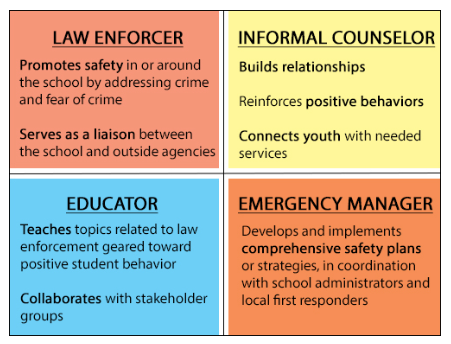This post was written by Associate Mike Niola and originally appeared in the May/June 2019 Issue of Campus Security & Life Safety.
Individual schools and districts are always seeking ways to increase their security posture while not losing what makes them uniquely qualified, as educational institutions, to create an environment where learning is invoked through programs, curriculum, and even the design and architecture itself. This includes implementing security policies and procedures, designing buildings in a way that has security in mind, proper training, and by exploring how technology could help with their overall security goals.
Another important aspect of the overall security program is the staffing of personnel responsible for different aspects of a school’s security. This may include school resource officers or volunteers such as ex-law enforcement or military veterans.

School Resource Officer – Image from Portland Press Herald
What is a School Resource Officer?
A school resource officer (SRO) is a sworn law enforcement officer responsible for safety and crime prevention in schools, as defined by the U.S. Department of Justice. Regulations dictate the experience and training that these individuals need, which go beyond a traditional officer’s toolkit. Like a traditional law enforcement officer, SROs generally carry a gun and other law enforcement equipment, have the ability to make arrests, respond to calls for service, and document incidents. In addition, they are also mentors, counselors, and educators, as outlined by the National Association of School Resource Officers (NASRO) and in most cases, they are a paid position.

School Resource Officer Roles – From the U.S. Department of Justice COPS Office
NASRO estimates that there are between 14,000 and 20,000 SROs currently in service in the U.S., and a 2018 report from the U.S. Department of Education reported that 42% of public schools reported that they had at least one SRO present at least one day a week during the 2015-2016 academic year.
What is a Security Volunteer?
A security volunteer could be anyone else that a school deems adequate as a responsible party for different security related tasks on a campus. They are not required to be sworn law enforcement officers and typically aren’t. Therefore, they also do not have the ability to make arrests or respond to service calls. Their responsibilities depend on what the school assigns to their role, but could range from watching entrances, patrolling the campus, and signing-in visitors to monitoring cameras and calling first responders during an incident. A security volunteer could be a paid or unpaid position, though it is often the latter.
Which Role Should You Implement?
There is no right or wrong choice when deciding what security staffing role to introduce to your school. These individuals address different aspects of your security program and could come with different skill sets. These roles could also entirely complement one another. The question is more about which resource could realistically be attained most quickly and efficiently given your current resources. For example, schools with existing relationships and programs with local law enforcement may more easily find a route to implementing a school resource officer; while schools in a community with a very involved and hands-on parent pool, but without funding available, may find that attaining a security volunteer would be an easier first step.
Other Considerations for Security Staffing in Schools
Hiring Veterans as School Security
In response to an increase in gun-related school incidents, a recent trend has emerged. More schools are looking towards bringing on ex-law enforcement or military veterans as security personnel on their campuses. This is typically being done through volunteer services which are not closely regulated.
Though the inclination to consider their backgrounds as unique qualifiers for the role may seem like an obvious connection to make, there are some important items to consider while making this decision. The training military and law enforcement veterans receive does give them key skills in security assessment, planning, and response. However, they have been trained to implement this in a much different environment than they will find in a school campus.
School Specific Training Is Needed
Additional training should be given in order to allow them to best translate those skills to school environments dealing with young students, particularly if they will be in K-12 schools. Training should augment their current skills to prepare them for the mentor and counseling roles that they may also be expected to undertake. Another key aspect that is often added is additional de-escalation training, learning how to arrive at a scene with students and properly de-escalate the situation, considering that sometimes having a law enforcement figure sprinting to a situation with improper body language could heighten tensions and have an adverse effect.
Even SROs, whom obtain school environment specific training, could benefit from additional training that is tailored for your campus and school community. You should consider creating a training program that allows them to learn from your counselors and staff so they can better integrate with your school. They should learn about specific concerns, risks, and procedures you have in place which they have to enforce or even help improve. This would allow them to better understand your environment and most efficiently provide positive effects.
Funding
Whatever the decision is for implementing an SRO, security volunteer, or both, schools have to consider their funding resources to add this additional role. SRO’s are typically paid at the rate of a police detective which is often higher than the average teacher’s or school counselor’s salary. This cost has traditionally been covered by the school district, however, some law enforcement agencies have created programs with schools to share in the responsibility of this cost. Additionally, state and federal grants are available to assist with these costs as well. For example, the U.S. Department of Justice’s COPS (Community Oriented Policing Solutions) office has provided over $14 billion in grants since their establishment in 1994 and continues to fund grants on a yearly basis.
The addition of security staff on your campuses is a great way to increase your security readiness, but make sure you’re putting your best foot forward by knowing the difference between an SRO and a security volunteer, and ensuring proper training is given to all individuals.

